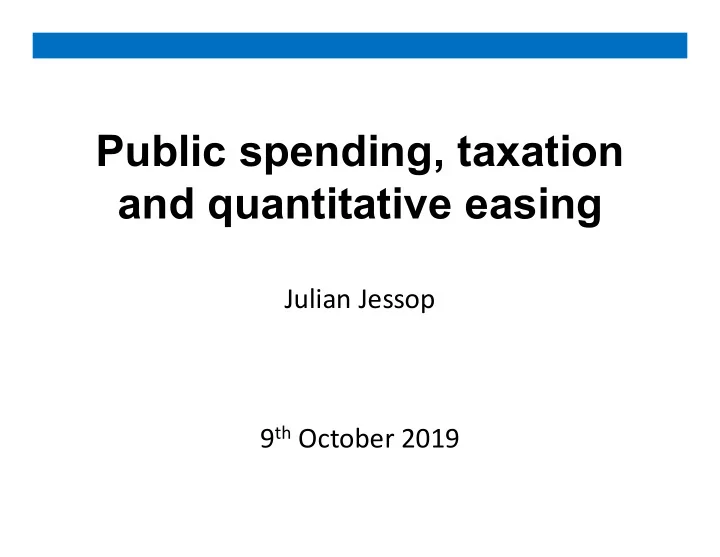

Public spending, taxation and quantitative easing Julian Jessop 9 th October 2019
Agenda • Defining ‘austerity’ • The UK public finances • Fiscal multipliers • The Laffer curve • Quantitative easing • Three questions for debate (with some suggested answers)
What do you think ‘austerity’ means?
Some definitions of ‘austerity’ • ‘Policies that aim to reduce government budget deficits through spending cuts, tax increases, or a combination of both.’ Wikipedia • ‘A situation in which people’s living standards are reduced because of economic difficulties.’ Collins Dictionary • ‘A discretionary tightening of fiscal policy intended to reduce the budget deficit.’ Julian Jessop
UK public sector borrowing (% GDP)
UK public sector receipts and spending (% GDP)
UK total managed expenditure (2018-19 prices) (Resolution Foundation)
Change in per capita spending between 2007-08 and 2019-20 (Resolution Foundation)
UK public expenditure on health
Fiscal Multipliers • A multiplier of 0.5 implies that a reduction/increase in government spending equivalent to 1% of GDP has the effect of reducing/increasing GDP by 0.5% • Why might it be less than 1? Cuts in public spending can free up resources for more spending by the private sector and lead to lower interest rates • But multipliers can be higher than 1 (as we shall see…). In general, multipliers are lower for current spending and indirect taxes (e.g. VAT), and higher for investment spending and income taxes. (Why?)
The Laffer curve • Simple idea: there is an optimal tax rate that maximises total tax revenues. Beyond that rate (but only beyond that rate) increasing tax rates reduces tax revenue. • Unfortunately, no-one knows what this rate is! Many academic studies suggest that the optimal tax rate is actually higher than the current rate … • … but in the real world, cuts in higher rates of tax are often associated with increases in revenue.
Quantitative Easing (QE) • The purchase of assets or making of loans using newly-created money (note the expectation that the central bank will eventually be repaid) • Works in one or more of the following ways: 1. Targeting particular assets or type of borrower 2. Reducing long-term interest rates (bond yields) 3. Raising inflation expectations 4. Increasing nominal GDP 5. Weakening the currency
Beyond conventional QE • Direct purchases of bonds from the government itself (i.e. deficit financing – usually not allowed) • Variations, e.g. buying bonds issued by a National Investment Bank (one form of ‘Peoples QE’) • Direct payments to individuals with no expectation of repayment (‘Helicopter money’, UBI?) • Risks? Loss of fiscal discipline. Threat to central bank independence. Excessive monetary expansion leading to inflation.
Three questions for debate 1. Was ‘Tory austerity’ justified? 2. How should fiscal policy respond to a ‘no-deal Brexit’? 3. Does the Bank of England need a new mandate?
Three questions for debate 1. Was ‘Tory austerity’ justified? 2. How should fiscal policy respond to a ‘no-deal Brexit’? 3. Does the Bank of England need a new mandate?
Was ‘Tory austerity’ justified? • Austerity undoubtedly delayed the recovery and damaged some public services, but was this a ‘price worth paying’ to avoid an even worse outcome? Deficit was unsustainably high (10% of GDP) Fears of Greek-style debt crisis, long depression Fiscal multipliers assumed to be small X Cyclically-adjusted deficit was more manageable X UK not Greece (in particular, not part of euro) X With hindsight, multipliers larger than expected • In addition, was the burden of austerity fairly shared between rich and poor?
IMF rethink on fiscal multipliers • At the start of the 2010s, IMF staff suggested that fiscal multipliers had averaged around 0.5 • However, new work suggests that multipliers have actually been well above 1 since the GFC (implying austerity was actually counter-productive) • Why? Because the usual offsets to public spending cuts don’t work as well if there are already plenty of spare resources, if interest rates are already near zero, and when lots of countries are implementing austerity at the same time
Three questions for debate 1. Was ‘Tory austerity’ justified? 2. How should fiscal policy respond to a ‘no-deal Brexit’? 3. Does the Bank of England need a new mandate?
How should fiscal policy respond to a ‘no-deal Brexit’? • Does ‘no deal’ limit room for manoeuvre - or is it right to let government borrowing take the strain? • What’s the nature of the shock? Trade barriers? Aggregate demand? Supply? Inflation? Confidence? • Who is affected most? Might want to target additional spending at, say, farmers, or tax cuts at low income groups. Measures to encourage (inward) investment? • Are there things only ‘no deal’ allows you to do? • Supplementary: how should monetary policy respond?
Three questions for debate 1. Was ‘Tory austerity’ justified? 2. How should fiscal policy respond to a ‘no-deal Brexit’? 3. Does the Bank of England need a new mandate?
Does the Bank of England need a new mandate? • BoE currently has an inflation target, a remit to maintain financial stability, and, subject to these, a general duty to support government policy • Previously it has also had monetary and/or exchange rate targets, but these are out of fashion (rightly?) • New ideas include targets for productivity and/or house prices (are these practical?) and a much more active role in demand management (‘beyond QE’) • Credible central bank targets have helped keep inflation low. If it ain’t broke, don’t fix it?
Thank you for participating
Recommend
More recommend